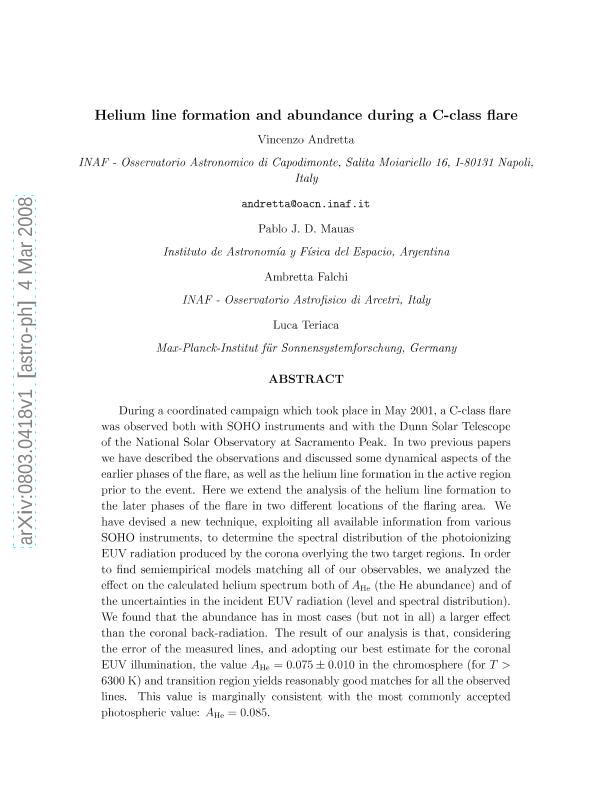Mostrar el registro sencillo del ítem
dc.contributor.author
Andretta, Vincenzo
dc.contributor.author
Mauas, Pablo Jacobo David

dc.contributor.author
Falchi, Ambretta
dc.contributor.author
Teriaca, Luca
dc.date.available
2017-07-18T18:26:15Z
dc.date.issued
2008-12
dc.identifier.citation
Andretta, Vincenzo; Mauas, Pablo Jacobo David; Falchi, Ambretta; Teriaca, Luca; Helium line formation and abundance during a C-class flare; IOP Publishing; Astrophysical Journal; 681; 1; 12-2008; 650-663
dc.identifier.issn
0004-637X
dc.identifier.uri
http://hdl.handle.net/11336/20815
dc.description.abstract
During a coordinated campaign which took place in May 2001, a C-class flare was observed both with SOHO instruments and with the Dunn Solar Telescope of the National Solar Observatory at Sacramento Peak. In two previous papers we have described the observations and discussed some dynamical aspects of the earlier phases of the flare, as well as the helium line formation in the active region prior to the event. Here we extend the analysis of the helium line formation to the later phases of the flare in two different locations of the flaring area. We have devised a new technique, exploiting all available information from various SOHO instruments, to determine the spectral distribution of the photoionizing EUV radiation produced by the corona overlying the two target regions. In order to find semiempirical models matching all of our observables, we analyzed the effect on the calculated helium spectrum both of A(He) (the He abundance) and of the uncertainties in the incident EUV radiation (level and spectral distribution). We found that the abundance has in most cases (but not in all) a larger effect than the coronal back-radiation. The result of our analysis is that, considering the error of the measured lines, and adopting our best estimate for the coronal EUV illumination, the value A(He)=0.075 +/- 0.010 in the chromosphere (for T>6300 K) and transition region yields reasonably good matches for all the observed lines. This value is marginally consistent with the most commonly accepted photospheric value: A(He)=0.085.
dc.format
application/pdf
dc.language.iso
eng
dc.publisher
IOP Publishing

dc.rights
info:eu-repo/semantics/openAccess
dc.rights.uri
https://creativecommons.org/licenses/by-nc-sa/2.5/ar/
dc.subject
Astrophysics
dc.subject.classification
Astronomía

dc.subject.classification
Ciencias Físicas

dc.subject.classification
CIENCIAS NATURALES Y EXACTAS

dc.title
Helium line formation and abundance during a C-class flare
dc.type
info:eu-repo/semantics/article
dc.type
info:ar-repo/semantics/artículo
dc.type
info:eu-repo/semantics/publishedVersion
dc.date.updated
2017-07-18T17:17:00Z
dc.journal.volume
681
dc.journal.number
1
dc.journal.pagination
650-663
dc.journal.pais
Reino Unido

dc.journal.ciudad
Londres
dc.description.fil
Fil: Andretta, Vincenzo. Osservatorio Astronomico di Capodimonte; Italia
dc.description.fil
Fil: Mauas, Pablo Jacobo David. Consejo Nacional de Investigaciónes Científicas y Técnicas. Oficina de Coordinación Administrativa Ciudad Universitaria. Instituto de Astronomía y Física del Espacio. - Universidad de Buenos Aires. Facultad de Ciencias Exactas y Naturales. Instituto de Astronomía y Física del Espacio; Argentina
dc.description.fil
Fil: Falchi, Ambretta. Osservatorio Astrofisico di Arcetri; Italia
dc.description.fil
Fil: Teriaca, Luca. Max-Planck-Institut f¨ur Sonnensystemforschung; Alemania
dc.journal.title
Astrophysical Journal

dc.relation.alternativeid
info:eu-repo/semantics/altIdentifier/url/http://iopscience.iop.org/article/10.1086/587933
dc.relation.alternativeid
info:eu-repo/semantics/altIdentifier/url/https://arxiv.org/abs/0803.0418
dc.relation.alternativeid
info:eu-repo/semantics/altIdentifier/url/http://iopscience.iop.org/article/10.1086/587933
Archivos asociados
